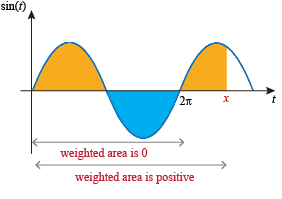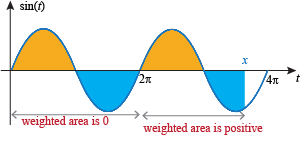As if one Fundamental Theorem of Calculus wasn't enough, there's a second one. The first FTC says how to evaluate the definite integral

if you know an antiderivative of f. The second FTC says how to build an antiderivative of f if you don't know one already.
Given a continuous function f and a constant a, we can define a new function F(x) by integrating f from a to x:

We can think of this new function F as an accumulation function—it accumulates the weighted area under f from a to x.

Given a continuous function f, we can build a new function F(x) by picking a lower limit of integration a and integrating f from a to x.
The Second Fundamental Theorem of Calculus says that when we build a function this way, we get an antiderivative of f.
Second Fundamental Theorem of Calculus:
Assume f(x) is a continuous function on the interval I and a is a constant in I. Define a new function F(x) by

Then F(x) is an antiderivative of f(x)—that is, F '(x) = f(x) for all x in I.
That business about the interval I is to make sure we only get limits of integration that are are reasonable for your function. Some things that wouldn't be reasonable:
- Choosing a = -1 for the function
 . Then
. Then
doesn't make sense because if x ≠ -1 we're trying to integrate a function over an interval where the function isn't even entirely defined.
- Choosing a = 1 for the function
 but then trying to evaluate
but then trying to evaluate
Again, we're trying to integrate a function over an interval where the function isn't entirely defined.
- Choosing a = 0 for the function
 . How would you evaluate
. How would you evaluate
The problem is that a = 0 isn't in an interval on which f is continuous. Actually, we can do stuff with this integral—it just requires some extra work, and we haven't gotten there yet.
- Choosing a = -1 for the function
 and trying to evaluate
and trying to evaluate
If I is any interval that contains both -1 and 1, the function isn't continuous on that interval. Again, we can do stuff with this integral, but we haven't learned how yet.
isn't continuous on that interval. Again, we can do stuff with this integral, but we haven't learned how yet.
We can condense this discussion into a short warning.
Be Careful: Whenever you go to evaluate an integral, make sure the limits of integration are reasonable for the function you're integrating.
If a function is discontinuous at or between the limits of integration we may still be able to evaluate the integral, but it requires a little extra sneakiness that we haven't gotten to yet.
So far, we've used the second FTC to build antiderivatives for things we already have derivatives for. That's not very exciting. Why go to all the trouble of writing

to get an antiderivative for sin x, when we already know that
-cos x
is an antiderivative of sin x?
It turns out there are many functions whose antiderivatives we don't know how to find. Some we'll learn how to find using various techniques of integration. However, there are many functions whose antiderivatives can't be written down with a nice formula. We can't write down a nice formula for the antiderivative of
eex
or
 ,
,
for example - not just because we don't know how, but because it can't be done.
The second FTC lets us build an antiderivative of f(x) even in the cases where it's impossible to write a nice formula for an antiderivative.
Example 1
Let f(x) = sin x and a = 0. Define
Find (a) F(π) (b) (c) |
Example 2
Let (a) F(2) (b) F(1) (c) F(0) (d) F(-1) (e) F(-2) |
Exercise 1
Let f(x) = sin x and a = 0. Define

Find each value and represent using a graph of sin t.
(a) F(-π)
(b) F(2π)
(c) 
(d) Consider all real values of x. For what values of x is F(x)
(i) positive?
(ii) negative?
(iii) zero?
Exercise 2
Let

Find each value and represent each value using a graph of the function (1 – t).
(a) F(3)
(b) F(1)
(c) F(0)
(d) F(-1)
(e) F(-2)
Exercise 3
Use the second FTC to build two different antiderivatives of the function f(x) = eex.




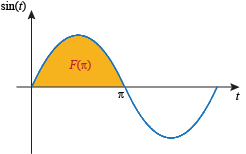

 we substitute
we substitute  in for x:
in for x:
 .
.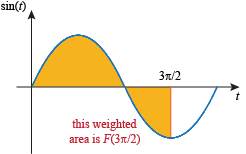


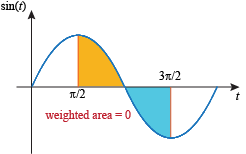

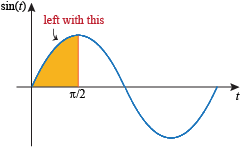
 ,
,
 we put in
we put in  for x. The upper limit of integration
for x. The upper limit of integration  is less than the lower limit of integration 0, but that's okay.
is less than the lower limit of integration 0, but that's okay.

 . This means we're integrating going left:
. This means we're integrating going left: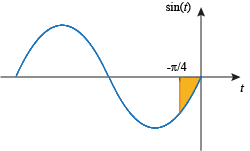
 . Find each value and represent each value using a graph of the function 2t.
. Find each value and represent each value using a graph of the function 2t.










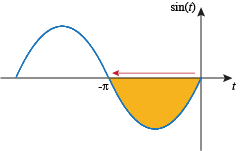

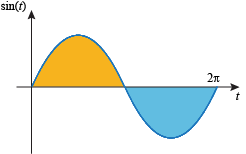

 :
: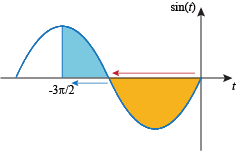
 is zero, because the areas above and below the axis on this interval are equal:
is zero, because the areas above and below the axis on this interval are equal: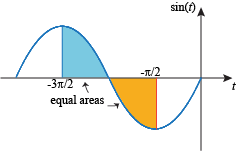
 , which is this area:
, which is this area:




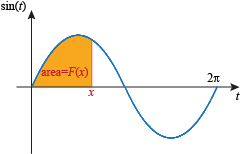


 , when we move x into the interval (2π, 3π] the values of F(x) are still positive:
, when we move x into the interval (2π, 3π] the values of F(x) are still positive: